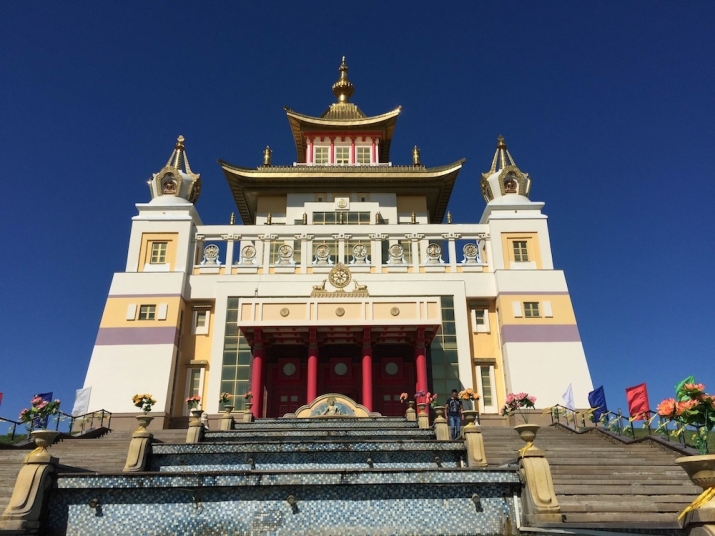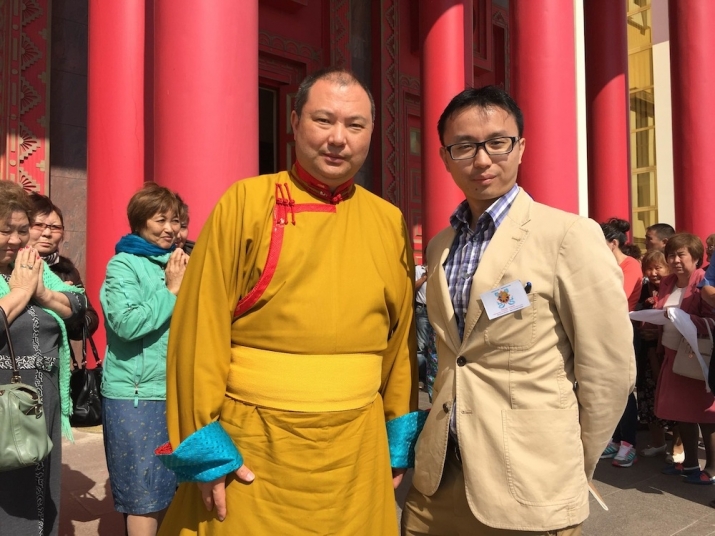FEATURES|THEMES|People and Personalities
The Kalmyk Restoration: Telo Tulku Rinpoche on a Russian Republic’s Buddhist Revival
 The Golden Abode of Buddha Shakyamuni, Elista, Kalmykia. Photo by Buddhistdoor Global
The Golden Abode of Buddha Shakyamuni, Elista, Kalmykia. Photo by Buddhistdoor GlobalThe Golden Abode of Buddha Shakyamuni graces almost every postcard, pamphlet, and webpage about the Russian republic of Kalmykia. Cast against the backdrop of a brilliant blue Russian sky, the monastery is awe-inspiringly large, and boasts an interior of intricate beauty equipped with a conference hall and meeting room. Yet this symbol of Kalmykia only opened its doors on 27 December 2005, even though Buddhism itself has existed in Russia’s south as a Gelugpa-Mongol religious and cultural hybrid for four centuries. The absent physical evidence for Kalmykia’s 400-year-old Buddhist presence points to a longer, sadder history.
The Kalmyks claim descent from the culturally diverse Oirat confederations (until their settlement in Russia, the Kalmyks also called themselves “Oirat”). The Oirat leader Güshi Khan (1582–1655) assisted the 5th Dalai Lama in winning political sovereignty over Tibet. By 1630, the Kalmyks had split from their mother clan and moved from Dzungaria (the northern half of the modern-day Xinjiang Uygur Autonomous Region) to the lower region of the Volga River, founding their own khanate. This split marked the beginning of a Gelugpa-influenced coexistence for the Kalmyks with their Russian overlords. When I visited the capital, Elista’s, government offices and the Palmov Kalmykia Republican Museum of Local Lore, I saw magnificent oil paintings of a meeting between Ayuka Khan (1669–1724) and Peter the Great (1672–1725). The first Russian emperor allowed the khan to rule the Kalmykian region in return for assistance against Russia’s foes.
Later, the Kalmyks endured Christian proselytizing by Russian Orthodox missionaries, intrusions by other settler groups, and the complete loss of sovereignty under Catherine the Great (1729–96), who abolished the Kalmyk khanate in 1771 and incorporated the Kalmyk people into the Russian empire. But it was the sledgehammer of Soviet-wrought destruction during the 1940s that truly devastated Kalmyk Buddhism. Hundreds of khurul (monasteries), choira (Buddhist colleges), and syume (temples) were demolished, and thousands of monks were forced to disrobe, were killed, or simply disappeared. Compounding the pain are the still-fresh memories of 27 December 1943, when the entire Kalmyk population was deported to Siberia under Stalin’s Operation Ulussy. By 1957, when the Kalmyks were allowed to return home, around 98,000 people—half of the original population—had died.
The Gelugpa revival in Kalmykia began in the late 1980s through two main channels: the re-emergence of public practice (Soviet persecution had forced families to practice Buddhism in secret) and the founding of new temples for the Kalmyks to enjoy their new freedom. Visits to Kalmykia by His Holiness the Dalai Lama in 1991, 1992, and 2004 added to a growing sense that Buddhism was on the rise. The rapid completion of the Golden Abode came thanks to the generosity of numerous private donors from across Kalmykia, but the protagonist behind its success is Telo Tulku Rinpoche, head lama (shadjin lama) of the republic’s Buddhist community (he also serves as the president of the Buddhist Union of Kalmykia and is spearheading the initiative to organize an annual conference rotating between the three Buddhist republics of Kalmykia, Tuva, and Buryatia).
I first met Telo Rinpoche in New Delhi in September. A straight talker, Russians and Kalmyks alike find his approach heartfelt and driven. One of his roles—to which he was appointed in October 2014—is honorary representative of His Holiness the Dalai Lama to Russia and Mongolia. He might have an American accent (he was born in Philadelphia in 1972 to the son of Kalmyk migrants; his birth name is Erdne Ombadykow) and appear relaxed and jovial, but Telo Rinpoche frames his story as one of personal redemption and moral awakening. At the age of seven, he was sent to Drepung Monastery in India and in 1991 joined the Dalai Lama on the latter’s first visit to Russia. It was his first time in Kalmykia, but being named shadjin lama by His Holiness earned him respect and engendered high expectations among many Kalmyks, who believed they could look forward to a leader with a sense of morality and monastic experience similar to that of the Dalai Lama. This wasn’t to be—at least not for some time. Although Telo Rinpoche was recognized at Drepung as the reincarnation of the Indian sage Tilopa, he dropped out of the monastery and disrobed in 1993 after 13 years, effectively quashing any expectations people may have had of him.
 Telo Tulku Rinpoche with Raymond Lam. Photo by Buddhistdoor Global
Telo Tulku Rinpoche with Raymond Lam. Photo by Buddhistdoor Global“I left out of stubbornness, ignorance, and stupidity,” Telo Rinpoche recalls. “When you think you know everything, that’s when you make mistakes. I said to myself that I wasn’t suited to this religious role, and I left.”
In February 1994, after Telo Rinpoche returned to the United States as a layperson, his elder brother was shot dead. “Out of my brothers he was the closest to me and I probably would say that I was going through a period of trying to find myself. I truly was lost, emotionally, spiritually, and financially. I was completely out of touch with the reality of my situation,” he says. After marrying a Tibetan woman in 1995 (his family still resides in the US), Telo Rinpoche returned to southern India, where he encountered the Dalai Lama again at Drepung Monastery: “I hadn’t seen him since I disrobed. It did cross my mind to maybe see him and seek guidance or advice, but I thought he had bigger things to worry about,” he says. To his discomfort, while Telo Rinpoche was waiting in line to greet him, the Dalai Lama walked up to him and said sternly: “I want to see you.”
Telo Rinpoche met with the Dalai Lama the following afternoon and was crushed to discover just how upset His Holiness could be in private. The disappointment and indignation in the Gelugpa master’s expression had a lasting impact. Telo Rinpoche recalls how the Dalai Lama reproached him: “Remember we met in this very room when you joined the monastery. You were this small then, and now you’re this big! And this is what you turn out to be!”
“I didn’t know how to react. Do I cry? It was too late to cry. Do I go back? You can’t go back. So you have to move forward,” says Telo Rinpoche. “I apologized to His Holiness, and I said to him that I’d live with my mistake for the rest of my life. I said to him that I was lost and didn’t know what to do. I had no guidance. He gave me a stern, long look. I sort of thought to myself, okay, now I’m in big trouble. And then he broke into this big laugh. He was compassionate, of course, and he said to me, ‘Well, you’ve already established a relationship with the people of Kalmykia. You must continue to serve them. You mightn’t be able to serve them as an ordained monk, but you’ll be able to achieve many good deeds.’”
Telo Rinpoche resolved to return to Kalmykia as soon as he could, and within two months he had left India. Once in Elista, he assembled a small team to organize cultural and religious events—from Cham dances to Kalmyk music concerts to Buddhist conferences. The team started off by renting spaces, but it soon became clear that a permanent multi-purpose complex would be necessary, and it became crucial to obtain the cooperation of local government bodies to assist with infrastructure and funding. “In the mid ‘90s it was a real struggle for me because I was dealing with a group of people who needed me to present to them how Buddhism was important and needed in the daily life of Kalmyk people,” he recalls. “Kalmyks will always be Buddhist. We celebrate Buddhist holidays and drape khatas [Tibetan ceremonial scarves] around our visitors and guests. It’s who we are and always will be. The government was the one that destroyed all our monastic institutions and assassinated or jailed all our scholars. They have an active, and yes, financial, responsibility to help us restore it. It took many years to convince them to assist us.”
Telo Rinpoche attributes his success in organizing Buddhist events and projects such as the Golden Abode to strong leadership traits, including faith, belief, self-confidence, and self-esteem. “When I assumed my duties in Kalmykia I was in my twenties, and these Communist officials were in their late forties, fifties, or sixties, you know? You have to find a way to gain their respect. It’s not a very easy thing to do, for men to respect a boy.
“One of the ways we earned the right to lead people, over many years, was being ethical in our work. Being transparent. Being honest not only with yourself, but with others. And we’re very much in debt to the people who opposed us, who criticized us, and didn’t believe in us,” Telo Rinpoche says, smiling. “Because of these people, we succeeded. They gave me the determination to prove them wrong. If our motivations, our intentions are right, we can achieve anything as long as we have patience and no ego.”
Despite the progress he has made, Telo Rinpoche confesses that he’s looking forward to retiring as soon as possible: “The younger generation are starting from a much stronger position than I did, and sooner or later they’ll have to take responsibility, whether they know how to or not. They’ll have to learn. I had no experience or learning when I started, but it was my determination and wish to help that drove me to where we are today. I’m hoping the younger generation have the same attitude as I do. Maybe they can be more creative or active.”
Telo Rinpoche is not oblivious to the fact that there are few young Kalmyks with the same charisma, or who command the same authority. “But I’m interested to see what they can do,” he says. “The reality is that our existence, our mission has to be a continuation of generations yet to come. We can’t wait for my death and another 20 years to find my reincarnation, to train him . . .” In some way he feels he has done his best to make amends for the mistakes that earned him a rebuke from the Dalai Lama. Telo Rinpoche hopes he has now done enough that he can be afforded the chance to be, in his words, “without worries; to be at peace. To have the opportunity to relax, to open a book; do some meditation; go on a retreat without having to worry if the temple bills are paid or if a project is finished; what guests are coming, what logistics need arranging . . .”
The restoration of Buddhism in Kalmykia is a relatively recent venture, but Telo Rinpoche feels the weight of four centuries of heritage and devotion on his shoulders: “I did it all for our people. My heart will always be in Kalmykia and to my very last breath, I’m going to be a Kalmyk.”














